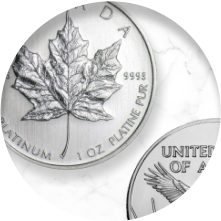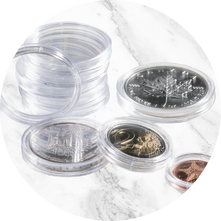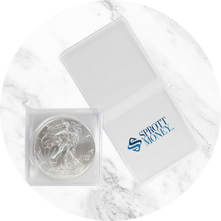Trying to Find the Bottom: Where Do Gold and Silver Go From Here? - Weekly Wrap-Up (November 15, 2019)

Nov 15, 2019
Precious metals bounced back a bit this week, and as the holidays fast approach, nervous investors are wondering what the season will bring. This week, Eric Sprott gives you all the gold and silver news you need to weather the winter in precious metals.
In this edition of the Wrap-Up, you’ll hear:
- How tax loss selling affects stocks—and how to know when it’s over
- Is there an end to the U.S. Ponzi scheme?
- Plus: What Eric’s watching next week
“There’s a number of anomalies, by the way, in the financial markets, and in particular, the precious metals markets. One of them being the recent performance of the junior silver stocks that have gone up about 15% in the last two weeks while the price of silver was going down. Which is very, very, very bizarre, OK? I would even say that the performance of the gold stocks has been pretty impressive in the face of the decline and the fear of a further decline. That’s been unusual.”
Male 1: You're listening to the "Weekly Wrap-Up" on Sprott Money News.
Craig: Hello again from Sprott Money News and sprottmoney.com. It is Friday, November 15th, 2019 and it's time for your "Weekly Wrap-Up." I'm your host Craig Hemke and joining us, as usual, this morning is Eric Sprott himself. Eric, good morning
Eric: Hey, Craig. We're trying to find a bottom here and lots of interesting things going on in the industry, in the economy. So, let's get her fired up.
.
Craig: We do have a lot to talk about so we better dive right into it. But of course, before we get started, I got something else for people to dive into. Silver is in high demand at Sprott Money and at sprottmoney.com.
So, the large ounce bars are literally flying off the shelves, the 100-ounce bars. So, in response to customer requests, we've added the PAMP Suisse 100-ounce silver bars to our inventory. You can find them on the website and purchase them directly at sprottmoney.com or of course, you can call us at 888-861-0775. The only good news about having price go down is a 100-ounce silver bar costs you about, well, a couple hundred dollars less than it did a just a couple of weeks ago, Eric, but we're bouncing back a little bit this week. What do you think?
Eric: Yeah. Well, you know, one of the great... But there's a number of anomalies, by the way, in the financial markets and in particularly the precious metals markets. One of them being the recent performance of the junior silver stocks that have gone up about 15% in the last two weeks while the price of silver was going down, which is very, very, very bizarre. Okay? I would even say that the performance of the gold stocks has been pretty impressive in the face of the decline and the fear of a further decline. That's been unusual. We also had the whole situation where we had record trading in the COMEX, the price going down, but the open interest went up, which I still can hardly explain because it's supposed to go the other way. The open interest is supposed to be going down because the banks would be covering their shorts but it looks like their shorts are even larger now because of the open interest. So, it's going to be interesting to see how this all unfolds. We all know there's a big December expiry coming up and we have about 10 trading days including today, I guess, before it expires. Then there's a huge open interest. It's, you know, something like 47 million ounces or something.
Craig: That's outrageous.
Eric: So, there's a lot of things have to happen to balance off the guys wanting to own it and the guys who are shorted, so we'll see how that transpires.
Craig: Hey, we've got a few other things we want to talk about before we get into the questions this week. But I think I'm going to work one in right here because you mentioned the junior silver miners going up even with prices going sideways. And that's certainly interesting, especially at a time when we're approaching tax-loss season. And you'd expect some of these junior silver miners to go down instead, but they're being accumulated. We had a question this week about your experience with tax-loss selling because we're going to...I don't know how much we'll see this year or not, since we had a good year, but how does that tax-loss selling typically affect stocks, juniors in particular? And how do you know when it's over?
Eric: Yeah. Well, first of all, there is tax-loss selling, particularly in a good year for stocks generally, because you want to...most people should have some kind of profit in stocks. So, you'll want to offset that by taking a loss. So, any precious metal security that's weak already will come under quite a bit of pressure. The pressure typically ends around really the last trading day of the month. But I might even target something like if one wanted to accumulate these things because they were knocked down, I would say December 15th is your start date, and then typically you get a lot of upside movement in late December, after the selling season for tax is over, and into January. So, that would be my suggestion.
Craig: Okay. Back to the week that was, Eric. It caught my eye this week when we had the first month of the new fiscal year down here in the States. The government fiscal year ends at the end of September, begins in October. The first month came in with a $134 billion budget deficit. Now, you can't see that a run rate of a one and a half trillion because there are some months where we actually take in some money. There's some tax receipts, but, my God, is there any end to this Ponzi scheme that we run down here?
Eric: It doesn't look that way. And I think rather than the absolute number of dollars, I think the more important thing is that the expenditures, the government expenditures, are up 7.6% and the revenue was down 2.8%. And both of those would make you pause and wonder what is going on here. Because by the way, the federal government spending 7.6% more, if it was sustained for year, would be 2% GDP if not more. So, you know, and of course, the fact that the revenues are going down is also...why our revenue is going down? We supposedly have all these people working. We have all these companies making all this money and revenues go down almost 3%. Like what the hangs going on here? Maybe that recovery is not as strong as we think it is. And maybe some of those employment numbers are kind of phony because guys have two and three jobs.
And we see this, like I believe the squeeze on the lower class or even middle class, middle class for sure. People just keeps going up. I saw something where auto delinquencies are something like $62 billion of delinquent subprime auto loans, $62 billion. That is not a little amount, okay. And what delinquent means haven't made a payment in three months. Wow. And we know there's been terrible abuse of those loans. People go and buy cars and, you know, they buy a $25,000 car and they end up with a $45,000 loan because the lender just rolls it. But now we're going to have these delinquencies are bad. And it's just a statement of what's happening to a class of people. Okay?
And we know the wage increase is not there. We know the inflation is there. God, we had CPI go up 0.4% this last month, that's 4.8% annualized. And then they say, we'll take food...and they take food and energy out of it. Well, excuse me, food and energy are two of the big ingredients. What do you mean take it out? That's what I pay. That's what I spend my money on. Anyway, so, I think that just goes on. The wealth effect just gets worse. The grinding of people, not just in the U.S., but, you know, we see all these disruptions in South America. And it's always because some government wants to raise some one more tax, one more time and the people just get fed up with it. They can't deal with it. And I think we think the world is experiencing that.
Craig: You mentioned that auto loan thing. Something that would probably slip through the cracks. I saw that though too. We're almost to a third of all new auto loans in the U.S. are for more than the cost of the car. And I think typically that's because, you know, everybody knows you drive the car off the lot and it immediately loses a third of its value and you get underwater. And so, you owe 30,000 on your current car. It's only worth 20,000 so that the dealership will loan you that 10,000 to pay off and then add that to the loan on your new car. I mean, it's madness.
Eric: Yeah. It's like subprime housing by the way, because everyone along the line is making a big fat fee that their booking as revenue. It always says revenues until the loan doesn't pay off, right? And then when the loan doesn't pay off, we all find out that, "Oh, that guy didn't really make as much money as he said he was making."
And I might point out that the Bloomberg Consumer Comfort Index came out. It's at the lows that we experienced back in '08 consumer comfort i.e. let's just call it the squeeze is on. Okay? The squeeze is on. You see it every day.
Craig: And you've probably seen the charts too, Eric, of how, I guess, unemployment, all of that seems to track the PMIs on about a 90-day lagging basis. And the PMI has had been crashing.
Eric: Right. There's all sorts of signs of things out there. By the way, I should mention that while Empire State Index came out this morning was weak. I found it very interesting that Uber just got a tax bill from the state of New Jersey for $650 million because they're not supporting the drivers in terms of healthcare and I guess social security and things like that. That's just one state by the way, 650 million. They already lose a billion a quarter. Imagine if a few states came in with looking for handouts like that. Anyway, it's part of the unicorn thing, right? Where all these guys have all these losses and somehow the private equity guys were willing to afford it. Thought it was a great model. Well, you know what? It isn't a great model, and it'll prove to be a disastrous model here.
Craig: It reminds me of all the dotcom, you know, pets.com and stuff like that from 1999.
Eric: It is the same sort of thing. "Just keep doing it. It's going to work. It's going to work. Keep doing it. Keep losing money, we'll take care of you." Only to find out that like WeWork. I think I just saw their, did I see their loss on the third quarter, 1.2 billion or something? Oh, my God. What kind of a theory is there that, "We were going to value that stock at $45 billion or something" and they were losing at an annualized rate of 5 billion? Have we gone mad?
Craig: The only difference between WeWork and the U.S. government is WeWork can't issue their own currency.
Eric: Yeah. And I see industrial production just came out of here now and it's down 0.8%. That's a pretty good rate of decline. That's 10% annualized, by the way, just so we all know.
Craig: Following along with those PMIs. All right. Hey, I've got again a laundry list of questions for you. And again, I just want to emphasize, we really appreciate everybody sending the questions and we have something like 30 of them this week. We can't possibly address every single company, obviously, but I do in the... As Eric and I get started before we begin to record, I ask Eric about every single one. So, okay. So, if you don't hear your question addressed or if you don't hear your company addressed, it's because Eric doesn't know anything about it or he doesn't feel qualified to answer. So, please understand that we look and we very much appreciate you taking the time to send us something. It's submissions@sprottmoney.com.
Eric, before we get to some specific miners, I just want to ask you about a couple of general questions that have been sent in. One had to do with microcap stock. We talked about it last week about your philosophy for buying them. Are they mainly kind of like accredited investment kind of things, you know, are they for regular investors, do you think, are they just too risky?
Eric: Well, as I said last week, size doesn't bother me, right? I mean, if you can do the work and figure out that something's cheap, the fact that it's small doesn't mean anything. You know, Starbucks was small at one time. McDonald's was small at one time. Amazon was small at one time. All these guys start off small and they were all microcaps at one time. And would we say, "Well, we would never touch those when they're small?" Hey, if you figured it out, you know what's going to work, you can easily buy them. So, I do it all the time.
Craig: Yeah. So, just do your homework. And it's really, I mean, and then obviously you have to be comfortable. It's got to fit your risk profile and, you know, all that kind of stuff. Eric, how about this then, another person wanted to know if you just do the math yourself or if maybe you employ a team of geologists to look at the company before you buy a portion of it.
Eric: Well, I'm embarrassed to say I don't have any geologists on staff. And I have a philosophical belief that a chartered accountant, which I am, is better at analyzing drill results than a geologist because the chartered accountant is putting it into dollars. He's thinking about dollars. The geologists is trying to think, "Well, how did they get there? Gee, that's interesting. I wonder what kind of structure is it?" and all that stuff. And I think a guy who can put it into dollars very quickly can make the move faster.
Now, you know, there's lots of times people make mistakes because some guy comes out with one good drill hole and then there's no follow-up. And that's a risk you always have to bear in mind, okay? You want to make sure you're not in a one-hole wonder here. You want to have some other information which suggest there's a reason for a deposit to be here. You know, not that the guy who's drilled beside a former hole that was good and now he's got exactly the same results and it was a one-hole wonder too. So, you got to do a bit of homework.
Craig: All right. Fair enough. One other question. This person says they're part of a group that meets on a regular basis deliberating about how the precious metals price discovery is really achieved, which you and I know is done through these digital derivatives and the fractional reserve scheme that the banks run. This guy just wants to know and understands how the creation of contractor and the open interest in new all-time high dilutes the float, creates more contracts to soak up the buying demand. But how is that any different from just shorting? I think the answer is self-apparent, but I'll let you take that one.
Eric: Well, what happens when there's a legitimate buyer of a COMEX contract, 99% of the time that COMEX contract is sold to them by a commercial bank short. And the banks essentially have 99% of the whole market is their market. Maybe there's some that's might actually be a producer hedging or it might be some speculator wanting to short. But for the most part, when we see the open interest rising, we see the short position going up commensurately. Well, who's selling the shorts? It's the banks who sell the shorts because they believe they have the power and it looks, you know, based on history, they have the power to move the price right back down when they want to, barring some unforeseen event. So, it's a game they play. And then, of course, they got all sorts of things outside of it where you've got gold options, you've got gold shares, you got calls on gold stocks, that you're also as a commercial bank, trading against your position. And when you know that you can take that price down, like they did in the last month, "Hey, if you short the gold stocks initially, you would have made money." I find it an interesting, that's why I find the more reason that these stocks are going up now. Maybe these bankers know the game's over, which it might very well be because if we have those incongruities going on in the COMEX, in the stocks. There's lots of reasons to think that maybe this time they might ultimately lose.
Craig: Eric, it's still early in the morning. You got to keep it...incongruities is too big a word for me. You got a...few less syllables. Okay?
Eric: Yeah. right.
Craig: All right. Now, thank you for it. That's a very good answer for that. I just want to run through some of these individual stocks before we wrap up. A lot of folks wanted to get your opinion on what's the Wallbridge drilling results and how that impacts Balmoral.
Eric: Sure. Okay. Well, first of all, the drilling results that were announced yesterday morning at 9:30. I really didn't have much time to look at them yesterday, but I spent my standard two hours looking at them today and it's very, very complex. But they looked fantastic. The Tabasco, what they call Lower Zone now, they did some undercuts of the great hole they reported two weeks ago, which was 37 meters of 27 grams. They did an undercut that I think was 70 meters downhole. And I think it had a 20-meter intersection of sulfides and lots of visible gold. So, the hope would be it'd be very analogous to the hole they reported two weeks ago. They stepped out. They undercut another hole in the to Tabasco Lower Zone on a different, it was south of the big hole they announced, and they got another big 30-meter intersection.
So, and they are in the process of drilling a hole that's going to undercut all of those holes by a further 200 meters. Well, my guy, you know, if that hole hits, we have 1000 meters of strike in the Tabasco zone and we've got good widths and good grades and you could end up with, you know, 400 meters of kind of a high-grade chunk down there. There would be a lot of ounces there. I'm also very hopeful that some of these other zones, for example, there's one called the Cayenne that is parallel to the Tabasco. It looks like it might be shaping up as we go deeper here too. It's early, early days to say that. And no one else has said that. When I look at some of the intersections of that, they look like they're pretty robust and getting thicker. So, we'll stand by in that.
The whole Area 51, they had an intersection of 272 meters of 0.68 grams, which is low-grade, but both minable. They talked about having 500-meter intersections that they haven't assayed yet near surface. And let's not forget that they took a big wildcat step out and went out 800 meters from the existing structure, which is only 1000 meters long, and they hit a visible gold intersection up there. So, I'm very excited by what's going on here. If any of you listeners have, you know, multiples of millions of shares, I'm allowed five purchase a year. So, if somebody like to share up to five million shares, call me.
Craig: 888-861-0775. No, I'm sorry. Okay. Hey, and I do have, again, we had this laundry list of companies. I've got five that I want to run past you real quick. So, again, thank you, everybody for sending in the names. These are the five that Eric thought he could comment on. One, Excellon Resources.
Eric: Sure. Well, I'm a big owner of Excellon. I did have a chat with management recently about what's going on and it looks like things are shaping up in Mexico in terms of the drilling and finding ore, and just around the existing mine network. They also made an acquisition in, was it Poland or Germany, which was an old silver producing thing and had very, very high grades. And they're very high on what they might expect there. And, you know, the silver price got so low that everyone's just has given up on silver, right? But I think the guys who are buying old ore bodies that still had lots of reserves when they were shutdown might find that as prices rocket up here, they've made great, great investments. So, I hope that happens with Excellon.
Craig: You thought of Eastern Europe as a big mining area. That's interesting.
Eric: Yeah, I know. That's the funny part, but there's lots of mining there.
Craig: Brixton Metals.
Eric: Brixton. Yes. They announced a hole a couple of weeks ago up in their Thorn property. It was a good hole. It wasn't as long as the first hole. And I think, unfortunately, I just can't take one hole to tell you the story there because you need more than what we've got so far. But, you know, I'm a believer that they're in the right area, each of the holes that they've announced this year are very, very extensively long holes with good grade. We just need more of them to say with certainty that we could have a mine up there.
Craig: Prophecy Development.
Eric: Prophecy, I recently invested in it. They have three operations. The one I was interested in is this silver operation in Bolivia. They have a very interesting down there, I'm forgetting the exact number of ounces of silver that they have. I think it's something like 80 million. It's in a prime area where there's been scads of silver produced over, you know, probably the last 400 or 500 years ever since the Spanish came over there. So, I'm buying it for those silver resources and they'll be drilling soon, I believe. And we'll see how it shapes up.
Craig: How about Silver One?
Eric: Silver One? Again, a silver-deposit owner, good deposit, decent grade. I'm banking on the silver price doing exceptional things and I'm willing to be patient and if they've got the ounces in the ground and that's my first inclination to go in, and they have ounces in the ground. I don't know the exact number of ounces, but it's not small. I think it's a good-sized operation.
Craig: And finally, Irving Resources
Eric: Irving, I got into through my association with a geologist friend of mine. And it's in Japan and they have a rather unusual ore body, a gold ore body, that they're drilling and test sampling. I think it's more sampling on surface that they've done so far and it's all worked out. The stock's done incredibly well. They hope it's an analogy with another significant ore body. I'm not remembering the name of it yet. It has been around for a long, long, long time and has produced more gold than you can imagine. And they think they have the same style of mine there. So again, patient, stock's done well, good people, it should do well.
Craig: And Eric, as we wrap up again, thank you for all your time. This is, I mean, you're just so generous to share it with us and answer all these questions. We're about even on the week, I see as we close here, I've got about 1466 in the December gold and 1686 in the December silver. Anything you're going to be watching in the next week?
Eric: Yeah, I'm going to watch Kirkland and Wallbridge.
Craig: I like it. Yeah.
Eric: It's funny, as you said, we're neutral. And we have any, you know, we're not neutral. Kirkland and Walbridge have both done well here. And, you know, it's funny how you can have horses that go against the grain and, of course between the junior silver stocks and then those two horses, it's been pretty good. And looking forward to lots of it,exciting things going forward.
Craig: And lastly by, I'm sure if you're a listener in Canada or U.S, you've noticed that winter is fast approaching if it's not already here. Anyway, it's at least a sure sign the holidays are upon us and everybody always look forward every year to the Sprott Holiday Catalog that you find at sprottmoney.com, really some of the best deals you're going to find all year. Maybe they'll pay and put some deals on those PAMP Suisse 100-ounce bars we're getting in. Anyway, this year's catalog will be full of those great ideas, again for friends, family, maybe even for yourself. You can find the catalog online at sprottmoney.com later today. We're that close to Christmas, Eric. Anyway, just a few weeks to go in a year, but I look forward to talking to you again next week.
Eric: Looking forward to it myself. All the best, Craig.
Craig: And from all of us at Sprott Money News, sprottmoney.com, thank you for listening. We'll talk to you again next Friday.
Don’t miss a golden opportunity.
Now that you’ve gained a deeper understanding about gold, it’s time to browse our selection of gold bars, coins, or exclusive Sprott Gold wafers.
About Sprott Money
Specializing in the sale of bullion, bullion storage and precious metals registered investments, there’s a reason Sprott Money is called “The Most Trusted Name in Precious Metals”.
Since 2008, our customers have trusted us to provide guidance, education, and superior customer service as we help build their holdings in precious metals—no matter the size of the portfolio. Chairman, Eric Sprott, and President, Larisa Sprott, are proud to head up one of the most well-known and reputable precious metal firms in North America. Learn more about Sprott Money.
Learn More
You Might Also Like:

















Comments